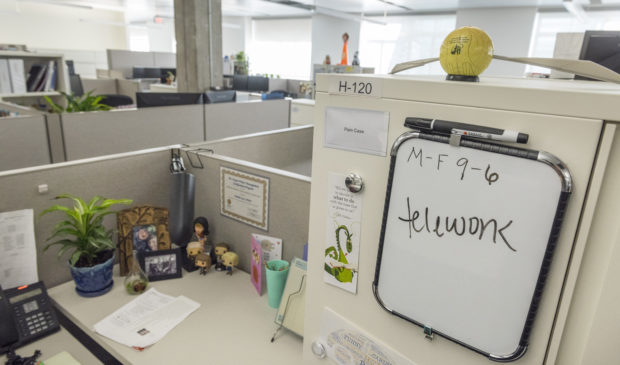County to identify funding source for implementing permanent teleworking
Wednesday, July 22, 2020 by
Jessi Devenyns Following a successful emergency rollout of teleworking capabilities in response to Covid-19 this spring, the Travis County Commissioners Court voted in May to make the digital work environment permanent for 75 percent of eligible county employees.
On Tuesday, commissioners took the next step in this transition process and directed staff to identify a funding source to hire a consultant to advise on this dramatic change to the county’s workplace. County staff estimated that hiring a consultant will cost $250,000. In conjunction with the funding, the Commissioners Court also told staff to create a scope of work listing the measurable objectives the county wants to achieve through the shift to teleworking.
The consultant will be responsible for crafting a pathway for the 479 county employees who are capable of shifting their duties into a digital environment. An analysis presented by the Teleworking Task Force found the vast majority of employees in the Auditor’s Office, Health and Human Services Department, Technology and Operations Department, Transportation and Natural Resources, and the Commissioners Court are eligible to telework between one and five days a week. Under Covid-19 stay-at-home orders, 2,300 county employees were telecommuting in May.
“Generally, I would be very leery about signing up for a quarter of a million dollars, but I think that if we do this correctly, this will be money really well spent,” Commissioner Gerald Daugherty said. He noted that in the long run, migrating a portion of the county workforce to a digital workspace has the potential to save on building costs and other expenditures associated with physically hosting employees in an office.
Paul Hopingardner, the CIO with the county’s Technology and Operations Department, told commissioners that over the past several years the county has invested in a large portion of the necessary technology to make remote work feasible. However, he noted that overhauling the workplace to be accessible from home is not just a technology-focused project. Successfully implementing a permanent strategy will require a framework that addresses employee safety and satisfaction, has an equitable distribution of resources, and mitigates liability and legal risk. “This is a fundamental change to the way we do business,” he said.
Hopingardner told commissioners that although large numbers of county employees are already working from home, the cohesion of this strategy is “fraying around the edges in some cases.”
Commissioner Brigid Shea, who has been pushing for the county to capitalize on the work-from-home momentum, acknowledged that there is a substantial difference between an emergency response and a sustained, ongoing operations system. “I have wanted to move on all of this as quickly as we can,” she said. “(But) we need assistance to put the right structures in place so we can be successful on an ongoing basis.”
County staffers hope to hire a consultant who will be responsible not only for refining the county’s teleworking policy but for assessing county operations to determine implementation procedures, piloting the program and rolling the policy out countywide. To determine what the county will require from a consultant, the commissioners and county judge will discuss the organization’s needs in more detail with staff at a work session.
Jessica Rio, the county executive with the Planning and Budget Office, suggested putting a placeholder for the consultant work on the change request list for the preliminary budget. She said this will secure the budget for the work to begin in 2021.
Commissioners and staff agreed that outside expertise is required to guide this initiative. Shea pointed out that guidance is especially valuable in a government setting, since transitioning to teleworking outside the high-tech sector does not occur frequently. “I think this is probably the boldest goal for a government institution,” she said.
Photo by the Oregon Department of Transportation made available through a Creative Commons license.
The Austin Monitor’s work is made possible by donations from the community. Though our reporting covers donors from time to time, we are careful to keep business and editorial efforts separate while maintaining transparency. A complete list of donors is available here, and our code of ethics is explained here.
You're a community leader
And we’re honored you look to us for serious, in-depth news. You know a strong community needs local and dedicated watchdog reporting. We’re here for you and that won’t change. Now will you take the powerful next step and support our nonprofit news organization?




